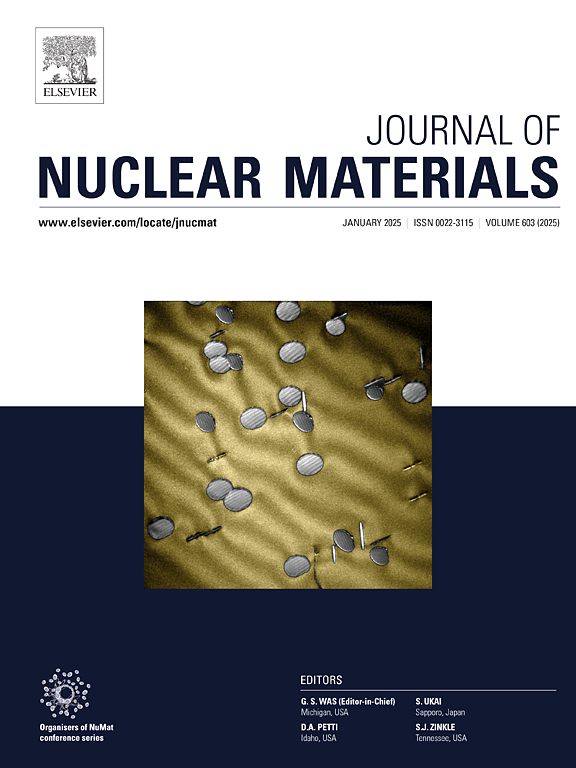Al涂层三元UMoX合金的热扩散行为
IF 2.8
2区 工程技术
Q3 MATERIALS SCIENCE, MULTIDISCIPLINARY
引用次数: 0
摘要
铀钼(UMo)合金的特点是Mo含量为7-10 wt.%,并保证在燃料成分中实现高密度的U组件,使其成为追求高中子通量的研究堆的一个引人注目的选择。然而,在燃料板中使用这些材料面临着许多挑战,主要反映在UMo核与Al基体或包层之间形成导热性差的非晶扩散层(IDL)。此外,还可以观察到燃料板的膨胀和气态裂变产物的积累。这些影响可以通过在燃料和Al基体/包层之间引入扩散间阻挡层(IDB)或使用三元合金(UMoX)代替二元UMo来抑制。本实验的重点是第二种方法,三元UMoX合金的研究。Zr, Pt, Nb和Ti被选为第三候选元素(X),因为它们的相关材料性质。实验工作涉及UMoX合金的生产,其中一部分样品在1173 K下进行热处理以实现均匀化。使用物理气相沉积(PVD)技术在所有样品上涂覆Al,以模拟Al基体和/或燃料板中的包层。对三元合金和二元UMo基准样品进行退火,模拟堆内运行时的扩散过程,研究γ相稳定性。结果表明,UMoTi和umazr由于相互扩散不均匀而不适合使用。与纯UMo相比,UMoPt形成了较薄且规则的IDL。UMoNb在长时间热处理下不发生相互扩散,化学性质稳定。总之,UMoNb和UMoPt是高密度燃料的有希望的候选人,提供了UMo燃料的更简单的替代品,因为它们不需要额外的IDB层。本文章由计算机程序翻译,如有差异,请以英文原文为准。
Thermal diffusion behavior of ternary UMoX alloys with Al coating
Uranium-molybdenum (UMo) alloys are characterized by 7–10 wt.% Mo content and offer assurance in achieving high densities of U assemblies in fuel compositions, making them a compelling option for research reactors in the quest for high neutron fluxes. However, the use of these materials in fuel plates faces numerous challenges, mostly reflected in the formation of an amorphous interdiffusion layer (IDL) with poor thermal conductivity between the UMo kernel and the Al matrix or cladding. In addition, swelling of the fuel plate and accumulation of gaseous fission products can be observed. These effects can be suppressed by introducing an interdiffusion barrier layer (IDB) between the fuel and the Al matrix/cladding or using ternary alloys (UMoX) instead of binary UMo. This experiment focuses on the second approach, the investigation of ternary UMoX alloys. Zr, Pt, Nb, and Ti are selected as the third candidate element (X) because of their relevant material properties. The experimental work involved the production of UMoX alloys, with a subset of samples undergoing heat treatment at 1173 K for homogenization. All samples were coated with Al using physical vapor deposition (PVD) to mimic the Al matrix and/or cladding in fuel plates. Both the ternary alloys and binary UMo reference samples were annealed to simulate the diffusion processes expected during in-pile operation and to study γ-phase stability. The results revealed that UMoTi and UMoZr are not suitable because of irregular interdiffusion. UMoPt formed a relatively thin and regular IDL compared to that of pure UMo. UMoNb did not show interdiffusion and was chemically stable under long heat treatment. In conclusion, UMoNb and UMoPt are promising candidates for high-density fuels, offering a simpler alternative to UMo fuels, as they do not require an additional IDB layer.
求助全文
通过发布文献求助,成功后即可免费获取论文全文。
去求助
来源期刊

Journal of Nuclear Materials
工程技术-材料科学:综合
CiteScore
5.70
自引率
25.80%
发文量
601
审稿时长
63 days
期刊介绍:
The Journal of Nuclear Materials publishes high quality papers in materials research for nuclear applications, primarily fission reactors, fusion reactors, and similar environments including radiation areas of charged particle accelerators. Both original research and critical review papers covering experimental, theoretical, and computational aspects of either fundamental or applied nature are welcome.
The breadth of the field is such that a wide range of processes and properties in the field of materials science and engineering is of interest to the readership, spanning atom-scale processes, microstructures, thermodynamics, mechanical properties, physical properties, and corrosion, for example.
Topics covered by JNM
Fission reactor materials, including fuels, cladding, core structures, pressure vessels, coolant interactions with materials, moderator and control components, fission product behavior.
Materials aspects of the entire fuel cycle.
Materials aspects of the actinides and their compounds.
Performance of nuclear waste materials; materials aspects of the immobilization of wastes.
Fusion reactor materials, including first walls, blankets, insulators and magnets.
Neutron and charged particle radiation effects in materials, including defects, transmutations, microstructures, phase changes and macroscopic properties.
Interaction of plasmas, ion beams, electron beams and electromagnetic radiation with materials relevant to nuclear systems.
 求助内容:
求助内容: 应助结果提醒方式:
应助结果提醒方式:


